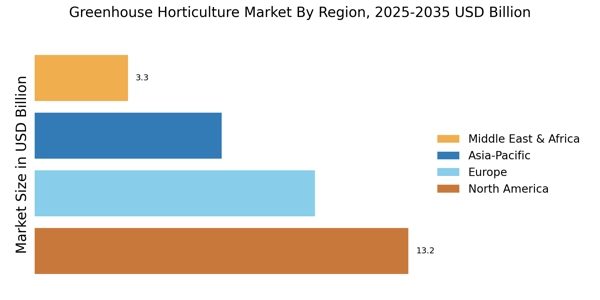Government Support and Policies
Government initiatives and policies aimed at promoting sustainable agriculture are significantly influencing the Greenhouse Horticulture Market. Many governments are providing financial incentives, grants, and subsidies to encourage the adoption of greenhouse technologies. For example, policies that support energy-efficient greenhouse designs and renewable energy use are becoming more prevalent. This support not only aids in reducing operational costs for growers but also aligns with broader environmental goals. Market data suggests that regions with strong government backing for greenhouse horticulture are witnessing accelerated growth rates. As these policies continue to evolve, they are likely to further stimulate investment and innovation within the Greenhouse Horticulture Market.
Rising Demand for Fresh Produce
The increasing consumer preference for fresh and organic produce is a primary driver of the Greenhouse Horticulture Market. As health consciousness rises, consumers are more inclined to purchase locally grown fruits and vegetables, which are often cultivated in greenhouses. This trend is reflected in market data, indicating that the organic food market has seen a compound annual growth rate of approximately 10% over the past few years. Greenhouses provide an ideal environment for year-round production, thus meeting the growing demand for fresh produce. Furthermore, the ability to control growing conditions in greenhouses enhances the quality and yield of crops, making them more appealing to consumers. This shift towards fresh produce is likely to continue, further propelling the Greenhouse Horticulture Market.
Consumer Awareness and Education
Increasing consumer awareness regarding the benefits of greenhouse-grown produce is driving the Greenhouse Horticulture Market. Educational campaigns and initiatives aimed at informing the public about the advantages of greenhouse cultivation, such as reduced pesticide use and enhanced nutritional value, are gaining momentum. As consumers become more informed, their purchasing decisions are increasingly influenced by the perceived quality and safety of greenhouse-grown products. Market data suggests that consumers are willing to pay a premium for produce that is marketed as sustainably grown in greenhouses. This heightened awareness is expected to foster a more robust market for greenhouse horticulture, as consumers actively seek out products that align with their values.
Urbanization and Space Constraints
The rapid pace of urbanization is creating unique challenges and opportunities for the Greenhouse Horticulture Market. As urban populations grow, the demand for locally sourced food increases, leading to a rise in urban greenhouse projects. These initiatives often utilize limited space effectively, employing vertical farming and rooftop greenhouses to maximize production. Market analysis indicates that urban agriculture is projected to grow significantly, with urban greenhouses becoming a viable solution to food security issues in densely populated areas. This trend not only addresses the need for fresh produce but also contributes to urban sustainability efforts. Consequently, urbanization is likely to be a key driver of growth in the Greenhouse Horticulture Market.
Technological Innovations in Horticulture
Technological advancements play a crucial role in shaping the Greenhouse Horticulture Market. Innovations such as automated climate control systems, hydroponics, and vertical farming techniques are revolutionizing traditional horticulture practices. These technologies not only enhance productivity but also optimize resource use, including water and nutrients. For instance, hydroponic systems can reduce water usage by up to 90% compared to conventional soil-based methods. The integration of smart technologies, such as IoT devices for monitoring plant health, is also gaining traction. As these technologies become more accessible, they are expected to drive growth in the Greenhouse Horticulture Market, enabling growers to produce higher yields with lower environmental impact.


















Leave a Comment